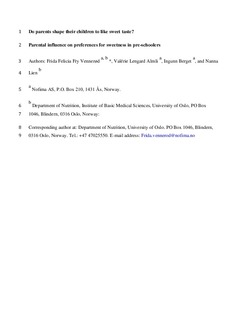Do parents form their children’s sweet preference? The role of parents and taste sensitivity on preferences for sweetness in pre-schoolers
Peer reviewed, Journal article
Submitted version
Permanent lenke
http://hdl.handle.net/11250/2502784Utgivelsesdato
2017Metadata
Vis full innførselSamlinger
- Artikler / Articles [1456]
- Publikasjoner fra CRIStin [2533]
Sammendrag
Children generally have a high acceptance for sweetness, but differ in their preferences for the intensity of the taste. This study investigates how food exposure, parental attitudes and behaviours, and children’s taste sensitivity are associated with five-year olds’ preferences for sweetness. Preference data were collected from 135 children at ages four (Mean age: 46.3 months, SD: 3.4, 56% boys) and five years old (Mean age: 57.5 months, SD: 3.3; 58% boys) in a ranking by elimination procedure in the springs of 2015 and 2016. The taste carriers were fruit-flavoured beverages and dark chocolate, both with three levels of sugar content. Quantitative descriptive analysis testified three distinct levels of sweetness in each sample triad. The same children were also tested for sweetness and bitterness taste sensitivity in a paired comparison procedure. The protocols did not require the children to respond verbally, and included elements of gamification in order to engage the children. In addition, a parental questionnaire enquired about exposure to different foods, parental food attitudes and behaviours as well as socio-demographic characteristics. Path modelling using PLS-SEM indicated that differences in children’s preference for sweetness could be explained by differences in exposure to foods, including more frequent exposure to sweet foods and snacks associated with a higher sweet preference. More frequent exposure to fruit and bitter snacks, were associated with a lower sweet preference for the drink and chocolate, respectively. Parental attitudes and behaviours as well as children’s sensitivity to sweetness and bitterness were significantly associated with what foods the children were frequently exposed to, and to their sweetness preferences in beverages and chocolate. Do parents form their children’s sweet preference? The role of parents and taste sensitivity on preferences for sweetness in pre-schoolers
